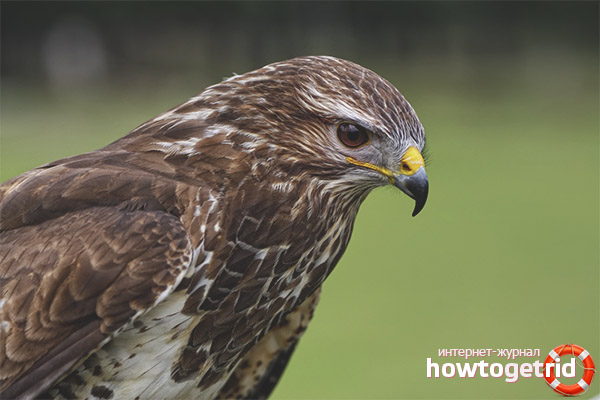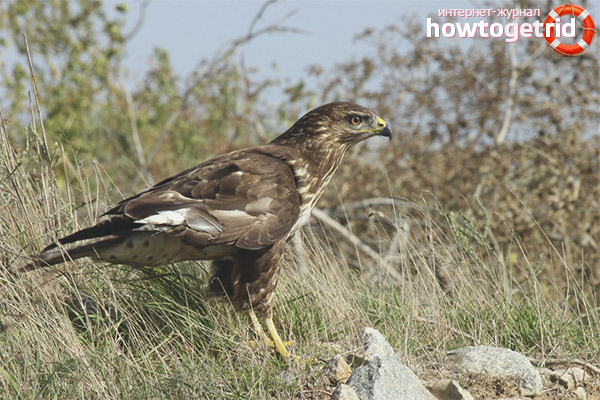The content of the article
Common Buzzard is one of the most famous and common feathered predators on the planet, related to day birds. Also, many people know this bird called the buzzard. The most common nesting site for the buzzard is picking in Asia and Europe.
Natural habitat
It should be noted that the population of such birds of prey that lead a daytime life, like the buzzard, can be divided into two parts, nomads and sedentary birds. For nesting of these predators, the territory of Europe is preferable (the exception in this case is the circumpolar regions). In Asia, this bird can be found in a temperate zone. In anticipation of the cold weather, the birds, whose main location is Asian countries, are migrating south.
The bird hunting ground is not only an open area (fields / meadows), but also quite dense forests. As a rule, in this case, for nesting, the buzzard chooses tall trees with a powerful and dense crown.
Bird guard
In some European countries, Common Buzzard refers to bird species protected by law. However, not long ago, the buzzard fired back, as it was believed that this bird of prey is a natural game fighter. In fact, this statement is partly true, as the buzzard attacks sick, weak or wounded animals. In fact, the common buzzard plays the role of a voluntary forest nurse, which helps maintain the health of entire populations of a wide variety of animals and birds (rabbits, hares, pheasants, and others). Sarych also brings considerable benefits to the agricultural sector through the effective destruction of harmful rodents, spoiling crops and crops.
Buzzard lifestyle
For hunting the buzzard uses several methods. Most often the buzzard, in order to look out for its prey, sits on some elevation and surveys the area adjacent to it. Having noticed the prey, the bird abruptly takes off in order to grab the victim with sharp claws.
Another way to hunt this bird of prey involves many hours in the air. Having outlined his victim, the buzzard quickly flies up to her in order to grab.
Mainly this bird of prey, whose weight reaches 0.8-1.2 kg, in the daytime hunts for such living creatures as small mammals - rats, field mice. Also often injured hares, young birds, snakes and lizards become prey of the buzzard.
Buzzard structure features

The bird's head is rather large and slightly flat. Due to the sufficient width of the wings, the buzzard can soar in the air for many hours, which helps him to see the desired prey (wingspan - up to 130 cm). The eyes of a bird are widely spaced, having an orange iris or a saturated yellow color.
The plumage of the buzzard is characterized by a rather changeable color. The main colors are brown shades. The sternum of a bird has a light color, as well as the inner side of the wings. The tail feathers in the tail section are distinguished by a reddish brown color with characteristic stripes having a transverse arrangement.
The buzzard has a fairly strong and large paws, feathered to the boarder. Sharp claws on the paws are used to capture prey. The bird's beak also has its own characteristic features - black with yellowish ceres, hook-shaped. The tail is rather short, in flight it opens with a wide fan. The life expectancy of a buzzard is up to 8 years.
Related species
Today it is known about several dozen species of the buzzard, which is often confused with eagles (about 30 species). Note that the silhouette of the buzzard really resembles an eagle; nevertheless, the buzzard is significantly inferior to the king in size. The main weapon of the buzzard in the hunt for small animals is sharp claws and a strong beak of a bird.
Breeding of birds of prey
If the common buzzard has created a pair, then it is for life.With the onset of spring, you can notice the unique mating flights of the buzzard. This spectacle can hit anyone - in the air birds perform unbelievable acrobatic stunts.
At the beginning of the marriage games, the partners have been in the air for quite a long time, while emiting characteristic loud sounds. After that, the male presents to the female the boar a small animal caught during the hunt or a sprig of a plant, thereby giving it signs of its attention.
The created pair builds its nest, as a rule, in the crown of a large and tall tree, mainly entering the cluster of dense vegetation located on the slopes of the rocks (shrub thickets). The design of the nest is quite massive - the diameter of the "hearth" of the buzzard reaches one meter.
The bucket uses thick branches, knots as a material for building a nest. The inner part is lined with moss, grass, sprigs of heather. Often a pair of buzzards uses one built nest for several years. Another feature of the buzzard's behavior is that on its territory these birds of prey can build several nests, but only one of them is used for breeding.
The laying of eggs by the female is carried out with the beginning of the warm period (spring, summer: from March to June). As a rule, the average number of eggs laid is 2-4 pcs. Pockmarked eggs are white with gray-brown patches. Hatching is performed during the month by both parents of the future chicks.
After the appearance of chicks, the female buzzard spends most of the time with them, warming its offspring. The task of the male at this time is to provide the extended family with food. As a rule, it is the female that is first fed with the food brought by the father of the family; the chicks only get what remains after it. After a few weeks, both parents begin to hunt and get food to feed their offspring.
When the chicks reach two months of age, they begin to learn to fly, after which, as a rule, they leave the nest. However, for about two months they remain under the strict supervision of their parents.
With the onset of autumn, parents will drive offspring from their territory. Sexual maturity of the buzzards comes when the age of the bird reaches 2-3 years.
Interesting facts about buzzard, buzzard ordinary
- The number of populations of buzzards living in a certain area directly depends on how attractive it is for these birds for its feeding characteristics - this factor is very important when choosing a place for nesting.
- Most of the created pairs of these beautiful birds of prey start the process of breeding their offspring only if the territory in which they nest abounds with necessary food, in particular, with small rodents. If there is not enough food, then in this case some of the foxes in this year do not hatch their offspring, the rest, if they lay eggs, then the latter in the clutch are much smaller than usual.
- One of the favorite resting places of buzzards is the pylons of high-voltage lines. Often this fact is the cause of the death of many birds due to electric shock. Therefore, at present, supports are installed that are absolutely safe for birds of prey and, accordingly, can prevent their death.
- I would like to draw attention to the fact that the land of the common buzzard is not only the territory, but also the airspace above it (up to 240 m.).In the event that any other alien bird appears in the air over the territory of the buzzard, the predator starts attacking it almost immediately. Birds that fly over the territory of the buzzard above the designated height - the predator simply ignores.
- In Scotland, buzzards are quite often visiting travelers confused with such a bird as an eagle, because of which the buzzards got the title of traveler's eagle among tourists. Often, most of the visitors, due to their inexperience, take the buzzard for one of the rare subspecies of the golden eagle.
- A buzzard is a rather cunning and intelligent bird that feels great both in freedom and in captivity.
- The people of the buzzard are often called the mouse mouse.
- In England, the locals call the buzzard "bussard", which can be translated as a meowing eagle. This is due to the sounds that this bird makes, very reminiscent of a cat's meow.
Video: Buzzard (Buteo buteo)













To send